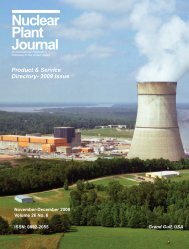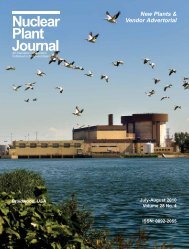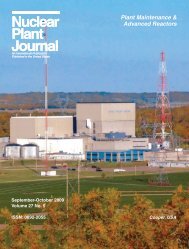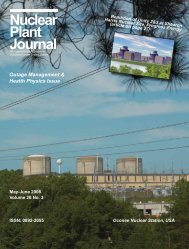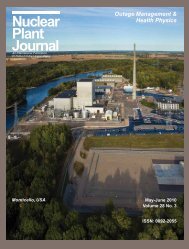Nuclear Plant Journal - Digital Versions
Nuclear Plant Journal - Digital Versions
Nuclear Plant Journal - Digital Versions
You also want an ePaper? Increase the reach of your titles
YUMPU automatically turns print PDFs into web optimized ePapers that Google loves.
of balance-of-plant corrosion products.<br />
This ceiling results from the logistical<br />
limitations of maintaining hundreds of<br />
cubic feet of ion exchange resins with a<br />
fi xed total exchange capacity, deployed in<br />
numerous polisher vessels, in the requisite<br />
H-OH chemical form.<br />
Millstone Chemistry determined that<br />
the problem could only be addressed by<br />
resolving the competing goals of high<br />
secondary pH and H-OH form condensate<br />
polisher operations. Millstone conducted<br />
bench top testing to determine if operating<br />
the condensate polishers in the amine<br />
(ETA) form might be a viable option. A<br />
mixed bed test column was set up for the<br />
purpose of evaluating the performance<br />
of DOW 650C cation resin that had been<br />
converted to the amine form, along with<br />
550A anion resin in the conventional OHform,<br />
during a simulated seawater leak.<br />
Implementation of this experiment<br />
required questioning the standard industry<br />
practice that selectivity is the dominant<br />
ion exchange mechanism between the<br />
liquid phase (condensate) and the solid<br />
phase (resin). Successful completion of<br />
this test would require displacement to<br />
Confi dent to...<br />
Continued from page 27<br />
• Implementing low Cobalt 316 LN<br />
for the Primary Loop Piping, thus<br />
mitigating potential (IGSCC and<br />
TGSCC) issues as well as reducing<br />
Man Rem exposures during maintenance<br />
outages<br />
• Implementing single piece forging<br />
technology for the hot leg with side<br />
nozzles to eliminate welds and inservice<br />
inspections<br />
• Implementing chrome- moly- and<br />
copper-containing steel grades in<br />
the Main Steam Piping, mitigating<br />
potential Flow Assisted Corrosion in<br />
the steam piping<br />
The AP1000 component design,<br />
material selection, fabrication processes<br />
factor in lessons learned from operating<br />
experience, best practices and knowledge<br />
from industry materials research programs.<br />
Because of these factors, Westinghouse<br />
has confi dence that the AP1000<br />
will deliver reliable performance of com-<br />
be considered the dominant exchange<br />
mechanism, not selectivity.<br />
The bench top test was successful in<br />
proving that amine form resin would provide<br />
the same level of protection to the<br />
steam generators from seawater ingress<br />
as the conventional H+ OH form resins.<br />
This successful testing shattered all<br />
previous beliefs and paved the way for<br />
this innovation in condensate polishing<br />
operations.<br />
Productivity/Effi ciency:<br />
The advantages of amine operations<br />
go well beyond cost savings, safety improvements<br />
and less environmental impact,<br />
as it also allows for greater operational<br />
fl exibility.<br />
While traditional H-OH charges required<br />
a cation regeneration approximately<br />
every forty million gallons and an anion<br />
regeneration approximately every fi ve<br />
hundred million gallons, amine charges<br />
merely require a mechanical cleaning every<br />
two to three billion gallons. Imagine<br />
the operational fl exibility associated with<br />
decreasing the need to perform work on<br />
a resin charge from approximately ev-<br />
ponents in the next generation of nuclear<br />
power plants.<br />
9. What are recommended practices<br />
for reactor pressure vessel in-service<br />
inspection to ensure that:<br />
a. Entire thickness of the reactor<br />
pressure vessel is inspected from different<br />
angles.<br />
The regulatory requirements for reactor<br />
pressure vessel in-service inspection<br />
mandate that only the welds and a defi ned<br />
amount of adjacent base metal be examined.<br />
Such examinations are volumetric<br />
(ultrasonic testing) and include the entire<br />
thickness. The examinations are conducted<br />
from the inner diameter surface<br />
of the reactor vessel and are designed to<br />
examine the full thickness in thickness<br />
zones. Different angles and techniques<br />
are defi ned for each zone.<br />
b. Nozzles and their associated<br />
welds are checked<br />
Nozzle-to-shell welds, nozzle innerradius<br />
regions and nozzle-to-pipe welds<br />
are examined in accordance with regulatory<br />
requirements.<br />
ery ten days to approximately every two<br />
years. Using all H-OH demineralizers<br />
Millstone was regenerating each charge<br />
on a ten day rotation; this meant one regeneration<br />
needed to be performed every<br />
thirty six hours. With the advent of amine<br />
operations we now have the luxury of not<br />
working certain resin charges for almost a<br />
two year period. This allows for the fl exibility<br />
to perform almost all corrective<br />
and preventative maintenance on-line,<br />
thereby reducing the impact and need for<br />
valuable resources to be used during outage<br />
periods.<br />
In addition, this reduction in regenerations<br />
reduces the operator time spent in<br />
the condensate polishing facility (CPF).<br />
Millstone has seen an almost 40% reduction<br />
in operator time required to support<br />
daily CPF operations.<br />
Contact: Lewis Crone, Millstone<br />
Power Station, Chemistry Department<br />
465/5, Rope Ferry Road, Waterford,<br />
CT 03685; telephone: (860) 444-5722,<br />
email: Lewis.E.Crone@dom.com. �<br />
c. Detecting fl aws in the welds in the<br />
reactor pressure vessel.<br />
Due to the safety importance of reactor<br />
pressure vessel welds, requirements<br />
dictate that the examination methods provide<br />
a high degree of reliability. To ensure<br />
this reliability, the examination procedures<br />
are required to undergo blind performance<br />
demonstration tests proctored<br />
by a third-party organization. Such tests<br />
involve representative component mockups<br />
containing implanted defects that are<br />
representative of postulated defects. The<br />
procedures must be demonstrated to detect<br />
100 percent of the critical defects. Once<br />
the procedure is demonstrated, then ultrasonic<br />
test personnel who are responsible<br />
for the examination must also undergo<br />
blind testing using the same set of mockups.<br />
Blind testing means that the defect<br />
population within the mock-ups remains<br />
unknown to the participants. This performance<br />
demonstration protocol ensures a<br />
higher integrity of examinations.<br />
Contact: Scott Shaw, Westinghouse<br />
<strong>Nuclear</strong>, 4350 Northern Pike, Monroeville,<br />
PA 15146, telephone: (412) 374-6737,<br />
email: shawsa@westinghouse.com. �<br />
<strong>Nuclear</strong> <strong>Plant</strong> <strong>Journal</strong>, March-April 2009 www.nuclearplantjournal.com 41



